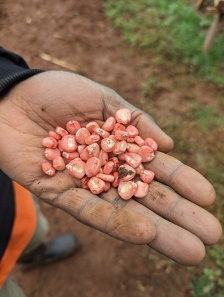An update from PhD student Turry Ouma
Since November 2023, our team has been preparing for our experiment in Kenya, beginning with comprehensive training, rigorous testing, and maintenance of the greenhouse gas analyzer-automatic chamber system. In January of this year, we established the experimental plots and installed automatic chambers to ensure uninterrupted measurements. With backup power and internet connectivity in place, we began collecting background measurements.
In February, we received the TREX (Trace Gas Extractor) instrument, along with essential equipment and tools for our measurements. This instrument will pre-concentrate N2O from ambient air and standardize the sample matrix. As the April rains arrived, we initiated agricultural activities by planting maize and potatoes, applying fertilizer, and concurrently collecting soil samples for subsequent analysis. By varying fertilizer application levels on maize and potatoes, we aim to uncover the intricate microbial pathways underlying N2O emissions. With the imminent arrival of the QCLAS (Quantum Cascade Laser Spectrometer), we anticipate completing the chamber-TREX-QCLAS setup and measuring the N2O isotopic composition using spectroscopy, eager to unveil the insights this data will provide.



Our overarching objective is to monitor N2O isotopic composition in Eldoret’s agricultural soils using laser spectroscopy and automatic-static chambers, with the goal of developing region-specific modelling approaches for Sub-Saharan Africa (SSA) to promote sustainable agricultural practices prioritizing environmental stewardship and food security.
The project is led by the Swiss Data Science Centre in partnership ETHZ’s Sustainable Agroecosystems Group, the International Livestock Research Institute and the University of Eldoret.
Image credits to Phillip Agredazywczuk and Turry Ouma.

Leave a Reply